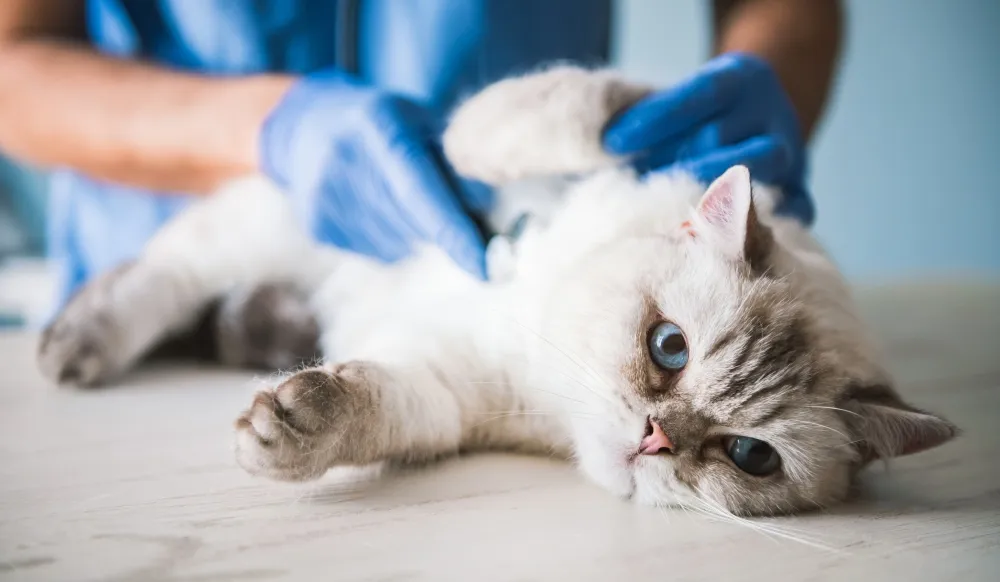Table of Contents
It’s probably no surprise that there are numerous parasites cats may encounter during their lives. One that many pet parents may be unfamiliar with causes an infection called toxoplasmosis. It is important that anyone with a cat understands how this parasite is transmitted and how to reduce the risk of infection especially because toxoplasmosis can be passed from cats to humans.
What is Toxoplasmosis in Cats?
Toxoplasmosis is an infection caused by a parasite called Toxoplasma gondii. Cats may develop toxoplasmosis after ingesting infected rodents or birds or contaminated soil. Once ingested, the parasite progresses through its life cycle within the cat. A cat who is exposed to this parasite for the first time in his life will start shedding oocysts in his stool and may develop symptoms depending on his overall health and age. Once these oocysts are shed, they become infectious after being exposed to the environment and can cause disease in other animals or people if they are accidentally ingested. After a cat stops shedding oocysts, the parasite becomes inactive, and the cat becomes a chronic carrier.
What are the Signs and Symptoms of Toxoplasmosis?
In many instances, cats may be infected with the parasite but show no signs of toxoplasmosis. However, if signs of infection are present, then can vary widely. Signs of toxoplasmosis may include:
- low appetite
- lethargy
- weight loss
- diarrhea
- vomiting
- jaundice (yellow discoloration of the skin and eyes)
- breathing difficulties
- fever
Toxoplasma gondii also has the potential to affect the eyes and brains of some cats, which can cause severe eye inflammation, incoordination, seizures, odd behaviors, confusion, abnormal vocalization, and head pressing. When these signs are present, the infection is considered more severe.
How is Toxoplasmosis in Cats Diagnosed?
There are various ways to diagnose toxoplasmosis in cats, one of which is a fecal float. During this test, a veterinarian will collect a small sample of stool from the cat and will look at it underneath a microscope to identify oocysts of Toxoplasma gondii that have been shed. Blood and other body fluids can be tested for the presence of antigens or antibodies to support a diagnosis as well. Lastly, tissues from the cat can be analyzed by a pathologist post-mortem to diagnose the infection.
How is Toxoplasmosis in Cats Treated?
Toxoplasmosis can be treated with an antibiotic called clindamycin or with a combination of pyrimethamine (an anti-parasitic) and sulfadiazine (an antibiotic). Clindamycin is the preferred treatment in cats, and it is typically given for a three- or four-week course to treat the signs of the infection [1]. If cats are experiencing severe disease, they may need to be hospitalized. During this time, they may receive intravenous fluids to help them feel better as well as additional supportive treatments as deemed necessary by the veterinarian.
Can Toxoplasmosis be Prevented?
To reduce the risk of toxoplasmosis, pet parents should keep their cats indoors so that they are less likely to come into contact with carriers of the parasite or contaminated soil. Pet parents should not offer their cats any raw or undercooked meat, as this can be a source of infection as well. Because the oocysts that cats shed must be exposed to the environment for a period of time before becoming infectious, pet parents should clean the litterbox daily while wearing gloves and washing hands thoroughly afterwards to reduce the risk of transmission.
Why is Toxoplasmosis Concerning?
Toxoplasmosis is a concern because it is considered zoonotic, which means it can be passed from cats to humans. This typically occurs when someone accidentally ingests an oocyst that has been shed in cat feces, either when cleaning the litterbox or when coming into contact with contaminated soil while gardening. If not properly cleaned before eating, fresh vegetables can also be a source of infection as well as undercooked meat.
Concerns During Pregnancy
This is especially concerning for pregnant women who, if they become infected during pregnancy for the first time, may pass the infection on to their fetuses. Toxoplasmosis can have significant detrimental effects on a fetus, including stillbirth, miscarriage, or the development of brain and eye abnormalities later in life. To reduce this risk, pregnant women should avoid cleaning the litterbox [1,2].
References
- Gaston, M. A. (2022, October). Toxoplasmosis in animals. Merck Veterinary Manual. Retrieved February 1, 2023, from https://www.merckvetmanual.com/generalized-conditions/toxoplasmosis/toxoplasmosis-in-animals
- Centers for Disease Control and Prevention. (2018, September 5). Disease. Parasites- Toxoplasmosis (Toxoplasma Infection). Retrieved February 1, 2023, from https://www.cdc.gov/parasites/toxoplasmosis/disease.html






